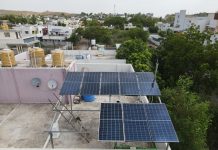Virtual Reality vs Augmented Reality :
Both Augmented Reality (AR) and Virtual Reality (VR) are the emerging technologies of today’s digital world. These are related to reality i.e. the world that surrounds us, but in a slightly different manner. In VR there exist a non-real environment (which may or may not resembles the real world) whereas in AR the real world that physically surrounds the user is super-imposed with computer generated graphics, either on cell phone screen or by using projection system , to enhance user experience.
In fact, Virtual Reality is a technology which is used to create a copy of the real environment and to give user an illusion to the real world. The environment created may either follow physics laws or maybe not and has no physical existence whereas, In AR the computer generated graphics (images), video, sound are added to the real world in real time, and the resultant can be viewed either directly (live view) or indirectly.
In AR, the direct view involves the use of optical projection system (projectors), where as indirect view includes monitors, display systems worn on human body, hand held devices. The augmentation is done in the real time after processing the inputs obtained from sensors (such as accelerometer), GPS, Camera, solid state compass and other devices. With the help of this technology we can easily give shape to our imagination. The technology allows modifying real world view by a computer, without changing it actually. On the other hand (i.e. in VR), in order to interact with the virtual environment or we can say that to support the presence of the user in the virtually created dimensions, special VR supported devices are needed. These devices include VR-Headsets, Data Glove and other game controllers (devices used to play games such as joystick). In order to view around the virtual world there is a need of a display. This is fulfilled by VR Headset which is similar to goggles with screen in-front of eyes. Other interactive devices include Data Glove, a glove worn on hand which facilitates tactile sensing and fine motion control. Since these devices are wearable, therefore a user can perform motions easily in the real world which works as input to sensory devices for purposes such as racking head, hand and body position, and then response accordingly.
Both AR and VR have a wide range of application. VR can be used effectively in Healthcare, Military Training, Video Gaming, Aircraft Simulations, Telecommunications, Sports, Construction, Fashion, Education, Entertainment and many more. And for AR, the list extends and includes Repairing, Navigation, Commerce, and Knowledge. The applications of these technologies are overlapping to a very large extent. The major part of development is done regarding cell phones because it is widely and easily available device today.
A number of tech-giants are working to enhance the utilization of both AR and VR. Google launched a number of applications to experience VR. Some of them are Tilt Brush (for 3D Painting), Earth VR (for exploring earth), Expeditions (for education) etc. The hardware family includes Sony PlayStation VR, HTC Vive, Oculus Rift etc. are some of the best VR Headsets till date. A variety of AR supported apps and games are also available in the market. Pokémon Go is one of the best examples supporting AR technology. At last, we can say that these technologies are going to give user, a tremendous experience of the real world.
Also Read :

























[…] source: https://www.hindipanda.com/virtual-reality-vs-augmented-reality/ […]